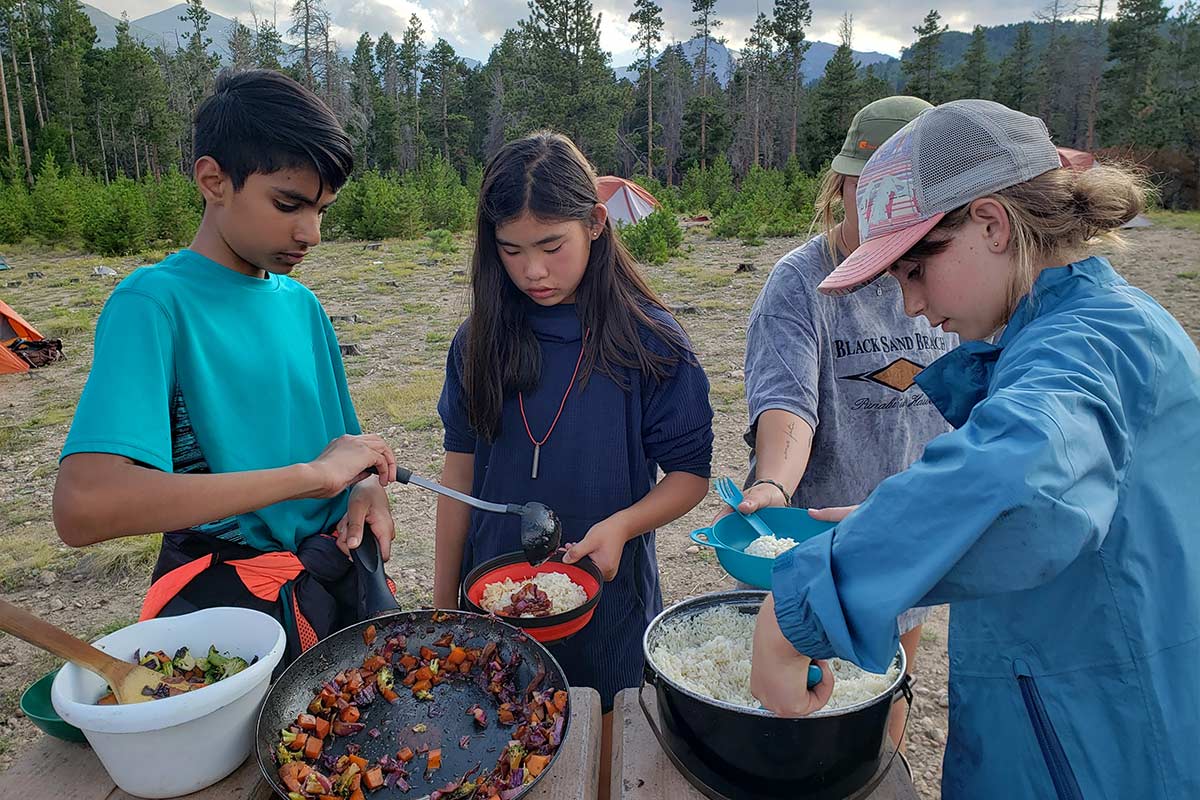Keystone Science School spends a lot of time camping in the backcountry whether it’s part of an overnight and challenge hike with Discovery Camp, or each car camping or backcountry experience on a KSS Adventure. No matter the program, KSS takes hygiene very seriously. By understanding how to maintain your hygiene and limit illness, we can ensure that everyone stays healthy while camping. Good hygiene in the backcountry is focused on keeping our hands and gear (especially kitchen tools) clean. Here are some steps that Keystone Science School takes to keep good hygiene when in the backcountry:
HAND WASHING
It’s important to wash your hands frequently when spending time outdoors, KSS makes it easy to wash your hands in the backcountry by providing biodegradable soap and water reservoirs specifically for hand washing. We set up hand washing stations so we can ensure to wash our hands before meals and after using the restroom.
MEAL TIMES
Anyone handling food or assisting in cooking for the group will wash their hands before touching any food or cooking materials. We limit the amount of hands touching things like serving utensils by minimizing the number of people assisting with meals. All dishes are thoroughly cleaned after each meal using clean water and biodegradable soap. To learn more about meals and how KSS handles Dietary Restrictions, please review the information on the Getting Ready for Camp web page.
WATER
Sometimes when camping in the backcountry, we have to collect water from running rivers and purify it before drinking or cooking. KSS purifies water using a chemical treatment in addition to water filters. All staff are trained on how to use filters to ensure water quality is healthy enough to drink or use for cooking and cleaning.
USING THE RESTROOM
Without easy access to modern bathrooms, using the restroom in the backcountry can be anxiety-inducing for many people. Knowing the proper way to go to the bathroom outside can help alleviate worries and help you feel more comfortable. We will follow Leave No Trace guidelines for how to use the restroom in the outdoors to minimize our impact on the environment. All practices will be taught to each group no matter their age or experience level. Using the restroom is an important concept to humanize and make sure that every camper is comfortable taking care of their basic needs.
PEEING OUTSIDE – NUMBER 1
When peeing outside, we need to find a spot that is at least 200 feet away from any trails, camps, or water sources. Any toilet paper needs to be packed out with us in order to be thrown away in a trash can. You can also designate a bandana to be your ‘pee rag,’ use it as you would toilet paper after peeing and attach it to the outside of your backpack to dry off in the sun. Each camper is given a ziplock bag to storage any used toilet paper or “pee rag.” Don’t forget to wash your hands!
POOPING OUTSIDE – NUMBER 2
Depending where you are, there are a few options for pooping when camping. Many developed campgrounds have pit toilets available for use. If there is not a pit toilet or privy, you will need to go at least 200 feet away from any trails, camps, or water sources. In some backcountry areas, you can dig a cathole by using a trowel to dig a hole as deep and as wide as the trowel. Poop in the hole and place any used toilet paper in a ziploc bag to pack out. If you don’t have toilet paper you can use natural materials like smooth rocks and sticks. Never use leaves or plants to avoid uncomfortable skin irritations and/or rashes. If using natural materials to wipe, place them in the hole and cover it with dirt before marking it by creating an “X” with sticks to ensure no one else digs in the same spot. You can also use ‘wag bags’ to carry out human waste and dispose of it properly. KSS will provide wag bags and staff will instruct all participants on how to properly use a wag bag once they arrive to camp. Wag bags consist of two trash bags, one larger one to poop in, and a smaller one to place the larger one in afterwards. As always, don’t forget to wash your hands!
SHOWERING
Without access to showers, a long day of hiking might leave you feeling sweaty and a bit smelly. Luckily, so will everyone else, so embrace the smell and make sure to focus on maintaining healthy practices like hand washing during your adventure! You will be able to shower when you arrive back at KSS campus.
With an emphasis on hand washing and maintaining good cleaning practices, we can be sure to stay healthy when car camping or backpacking! If you have any questions or concerns about hygiene in the backcountry, feel free to call 970-468-2098 or email Support@KeystoneScienceSchool.org.




